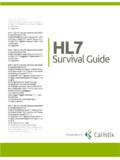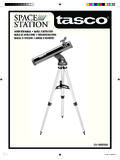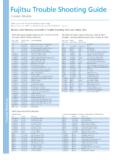Transcription of Interface Engine Migration Guide: From Oracle …
1 Migration guide EGATE TO orion health rhapsody 1 Interface Engine Migration guide : From Oracle e*Gate to orion health rhapsody integration Engine Migration guide EGATE TO orion health rhapsody 2 Table of Content Introduction .. 3 Workflow Recommendations .. 4 Step 1: Gather Interface Requirements .. 4 Step 2: Setup the New Interface .. 8 Step 3: Migrate the Interface .. 9 Step 4: Validate the Interface .. 10 Step 5: Move into Production .. 13 Making Your Team Productive .. 14 Feedback .. 14 Resources and Contributors .. 15 Migration guide EGATE TO orion health rhapsody 3 Introduction With DataGate/eGate at the end-of-life mark, you may be one of many hospitals and health systems trying to replace eGate engines with a newer technology.
2 Once you ve selected the Interface Engine you plan to move to, you know there is a lot of work ahead! The biggest investment isn t the software licensing or your incremental hardware costs. Your most costly line items will be the development and implementation time labor costs. The goal of this paper is to help in the design of a Migration project from eGate to orion health rhapsody integration Engine with consideration to the various elements you ll need to include. We ll recommend a workflow to improve team productivity and reduce those labor costs. In addition, we ll offer guidance on how to accomplish this using Caristix Workgroup software and the eGate and rhapsody connectors.
3 The Trial and Error Loop It s pretty common in the industry to have developers jump right into the code. Requirements are often incomplete or partial and the data to be exchanged is not well understood. With this incomplete process, developers start to code and send messages to the new Interface . Issues start to pop up rapidly. The code is then edited for a quick fix. Though issues may be fixed quickly, others appear and you re off and into the trial and error loop in a reiterative rinse and repeat cycle. The problem with this approach is that the number of issues and the time required to make corrections is unknown.
4 Your team keeps working until no new issues are discovered, in other words, until the end of the project. In addition, if your test coverage is not exhaustive, chances are issues will not be discovered until the Interface has moved into production. Migration guide EGATE TO orion health rhapsody 4 Workflow Recommendations The following proposed workflow describes a technique to speed up eGate to rhapsody Migration project execution and increase the quality of deliverables. There are five stages in Interface Migration : 1 - Gather Interface Requirements 2 - Setup the New Interface 3 - Migrate the Interface 4 - Validate the New Interface 5 - Move into Production This suggested workflow can scale to several hundred up to potentially thousands of interfaces.
5 We ll focus on how several manual tasks can be automated to speed up the process while reducing error and producing higher quality interfaces and documentation. We ll also cover how to achieve the level of automation required to effectively validate new interfaces while increasing the productivity of your Migration team using orion health rhapsody and Caristix Workgroup. These recommendations remain valid even if you are not using the tools described or are using different integration Engine technologies. In general, this process can still help you structure and standardize Migration projects.
6 For simplicity, the recommendations do not consider the usage of canonical or standardized models. A few steps would vary but the overall process is compatible. Please do not hesitate to contact us for more details. In addition, the recommendations do not address separate development and production environments, nor discuss network issues. Step 1: Gather Interface Requirements To write new Interface code and validate new interfaces, the first step is to clearly define the Interface requirements. Identify and answer any questions related to what the current Interface running on the legacy infrastructure accomplishes.
7 Often, interfaces are not well documented and several business rules and data logic are not necessarily known. Just looking at the Interface code will not be enough to gather requirements. You need to understand the system workflows, the data to be exchanged, the format of that data, and the data semantics. Migration guide EGATE TO orion health rhapsody 5 1. What data is exchanged? Once the overall workflows are defined, you ll know exactly what data is sent and what data is expected on the receiving end. Pay attention to the fact that sometimes the data semantics differ on both sides of the Interface .
8 2. What data formats are used? Now that you know what data will be transmitted, you need to understand the sending system data format and the receiving system expected data format. Data formats would usually be different on each side of the Interface . Understanding inbound and outbound message formats helps you list transformation requirements. Getting a detailed conformance profile (HL7 specification) for each system involved in the Interface is a good start. Here are two downloadable examples of an Interface spec or profile, one in Word and the second in Excel.
9 EGate also uses ETD (Event Type Definitions) describing message formats, which serves as a good source as it contains customizations. Export them to a document to work with and build documentation. Note: Keep in mind that building HL7 specifications out of a single or just a few message examples is not enough. You need to understand the various message customizations and semantic variances applied to specific clinical and sending application flows. 3. What data pieces must be transformed and how? HL7 is a hairy beast. To tame it, more than pipe counting is needed.
10 The HL7 standard is so flexible that each system has its own interpretation of the standard. It s not just the Z-segments, customized fields and tables are also very common. To get a complete list of transformations required, a thorough gap analysis is key. What is an HL7 Specification? As HL7 International states in the standard definition: An HL7 message profile (or HL7 specification) is an unambiguous specification of one or more standard HL7 messages that have been analyzed for a particular use case. It prescribes a set of precise constraints upon one or more standard HL7 messages.







